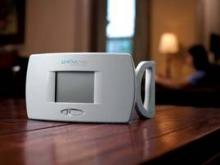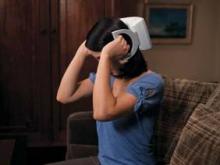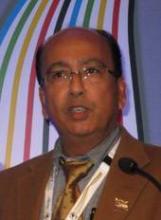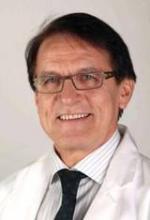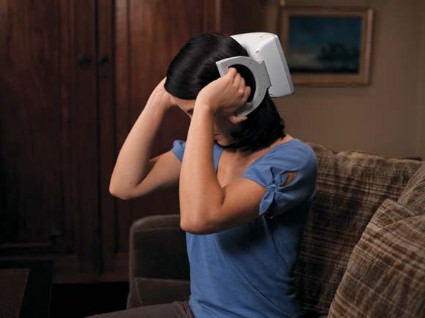User login
LONDON – Enthusiasm is mounting among headache specialists for noninvasive device therapy for acute migraine.
"Normally I’m quite a cynical person, but I think within 10 years time half of my people in the headache clinic won’t be using any medications for their headaches. They’ll have an electronic device of some kind. You get your migraine sorted out, you put your device back in your pants pocket, and you carry on," Dr. Fayyaz Ahmed said at the European Headache and Migraine Trust International Congress.
"I think in about 10 years time you’ll have SIM cards for these neurostimulatory devices, you’ll put the card in an ATM-like machine – perhaps in a supermarket – and you’ll top it up and recharge it," predicted Dr. Ahmed, a consultant neurologist in Hull, England, and chair of the British Association for the Study of Headache.
The noninvasive neurostimulatory therapy most discussed at the congress was the Spring TMS single-pulse transcranial magnetic stimulation device, which since 2011 has been approved in Europe for the acute treatment of migraine. The Spring TMS device is manufactured by U.S.-based eNeura Therapeutics, which is seeking marketing approval from the Food and Drug Administration.
The international congress also saw the presentation of the first multicenter, randomized, sham-controlled study of the noninvasive Cefaly device for prevention of migraine via supraorbital transcutaneous neurostimulation.
"It’s not a revolutionary therapy. The effect size is moderate and inferior to that of the most effective preventive drugs. Its great advantage is that it’s devoid of side effects. I think the Cefaly device is another tool we can use for preventing migraine," Dr. Jean Schoenen concluded in presenting the study data.
Dr. Ahmed said physician and patient interest in noninvasive device therapy is being driven by the sizable proportion of migraine patients who don’t respond adequately to drug therapy, can’t tolerate it, or have contraindications to its use. Plus, some patients would just rather be drug free.
Neurostimulatory therapy for headache has followed an evolutionary process, progressing from highly invasive to minimally invasive and now to noninvasive devices, the neurologist observed.
First came deep brain stimulation of the subthalamic nucleus via implanted electrodes, which proved useful in treating Parkinson’s disease.
In the field of headache, there are 14 published studies of deep brain stimulation of the ventroposterior hypothalamus for treatment of intractable chronic cluster headache in a collective total of 64 patients. Two-thirds responded with at least a 50% decrease in pain. But this highly invasive form of therapy is not effective as acute therapy, only for prevention, and it entails a 3% rate of intracranial bleeding.
Next came minimally invasive systems for occipital nerve stimulation. Response rates have been variable in 10 published studies totaling roughly 500 patients treated for chronic migraine. In addition, the devices are quite expensive and are susceptible to lead migration or breakage and battery depletion.
"Only a couple of centers in the U.K. are doing occipital nerve stimulation now," according to Dr. Ahmed.
Yet there is still commercial interest in developing minimally invasive neurostimulatory therapy for headache. During the London headache congress, St. Jude Medical announced that its Eon family of neurostimulators had just received European regulatory approval for treatment of intractable chronic migraine. Among the newly approved devices is the Eon Mini, which weighs about an ounce and has a 10-mm profile.
The recently published 12-week, double-blind, multicenter pivotal study sponsored by St. Jude Medical involved 157 patients with chronic migraine randomized 2:1 to peripheral nerve stimulation or sham control. Of patients on active therapy, 35% achieved at least a 30% reduction in pain, a rate more than twice that in controls. The active treatment group also had a mean 6.1-day reduction in headache days per month from a baseline of 22 days, compared with a 3-day reduction in controls (Cephalalgia 2012 Oct. 3 [doi: 10.1177/0333102412462642]).
A company spokesperson said St. Jude Medical definitely plans to seek U.S. marketing approval for its Eon neurostimulators.
The best-studied noninvasive neurostimulatory device therapy for migraine is the single-pulse transcranial magnetic stimulation Spring TMS device. It delivers a complete treatment in less than a minute at the first sign of migraine pain and has a side effect profile similar to that of sham therapy in clinical trials, according to Dr. Kevin G. Shields, a neurologist at the National Hospital for Neurology and Neurosurgery in London.
Single-pulse transcranial magnetic stimulation has been in clinical use for 30 years, first diagnostically, then as therapy. The mechanism of benefit has been mapped out. The treatment’s safety is very well established; indeed, the FDA has classified it as a nonsignificant risk technology, he noted.
The major technical advance that’s occurred in single-pulse transcranial magnetic stimulation has been a radical reduction in capacitor size. The equipment has shrunk from refrigerator-size in the therapy’s early development, which took place in London, to the highly portable Spring TMS device that patients can stick in a briefcase and utilize unobtrusively at work, Dr. Shields observed.
The contraindications to use of the device are a history of epilepsy; the presence of metal objects in the head, neck, or upper body; and pacemakers or other cardiac devices.
The evidence base supporting the safety and efficacy of the Spring TMS device includes a published randomized, double-blind, sham-controlled clinical trial conducted in patients with migraine with aura (Lancet Neurol. 2010;9:373-80).
In addition, at the international congress Dr. Mark W. Weatherall of the University of Edinburgh, Scotland, presented the first results of an ongoing multicenter U.K. postmarketing study of the single-pulse transcranial magnetic stimulation device as used in clinical practice. The study population consisted of 13 patients with migraine without aura and 24 having migraine with aura who had been using the device for at least 3 months and collectively had treated 777 attacks.
Efficacy reports were:
• 73% of patients said the device showed good to excellent efficacy, reducing or even alleviating migraine pain. Sixty-three percent pronounced the therapy effective in diminishing other migraine symptoms.
• 55% reported a reduction in the number of headache days per month.
The mean attack duration was 2.46 days before transcranial magnetic stimulation therapy and 0.77 days after subjects started using the device. The benefits were reproducible over the 3-month study period and beyond, and no adverse events were reported, he said.
Dr. Jean Schoenen presented the first randomized trial data on the Cefaly device. The supraorbital transcutaneous neurostimulation device has been available in Europe for 5 years, but until now it had no supporting data from controlled trials.
The device consists of a thin silver band that looks like something out of Star Trek. It is hooked over the ears and worn across the forehead like futuristic sunglasses. Patients don it once daily for 20 minutes. The investigators set the programmable device to deliver a square pulse at 60 Hz, 300 microseconds, and a maximum of 14.99 mA.
The 3-month, multicenter, double-blind, sham-controlled Belgian study involved 67 patients with episodic migraine. The mean number of headache-days per month dropped significantly, from 6.9 at baseline to 4.9 at 3 months in the Cefaly group but was unchanged in controls. Thirty-eight percent of patients using the active device experienced at least a 50% reduction in their number of headache-days per month, compared with 12% of controls. Monthly consumption of triptans for acute therapy was reduced by 36% in the Cefaly-treated patients as a whole and by 75% in the Cefaly responders, reported Dr. Schoenen of the University of Liege, Belgium.
To get a crude idea of how supraorbital transcutaneous neurostimulation stacks up against standard prophylactic drug therapy, Dr. Schoenen turned to the extensive published randomized trial literature on topiramate. While the 50% or greater responder rate in the Cefaly trial was 38%, in the pooled topiramate data it’s 45%. Moreover, topiramate was associated with an impressive average 48% reduction in the number of migraine attacks per month, compared with a 19% decrease with the Cefaly device.
On the other hand, one in four patients assigned to topiramate in the randomized trials dropped out due to side effects. No one experienced any adverse effects from the device therapy, he noted.
This was an investigator-initiated study carried out by the Belgian Headache Society and sponsored by STX-Med, which markets the Cefaly device in Europe. Dr. Schoenen is on the advisory boards of St. Jude Medical, Allergan, and ATI. Dr. Ahmed, Dr. Shields, and Dr. Weatherall are on the speakers bureau for eNeura Therapeutics.
LONDON – Enthusiasm is mounting among headache specialists for noninvasive device therapy for acute migraine.
"Normally I’m quite a cynical person, but I think within 10 years time half of my people in the headache clinic won’t be using any medications for their headaches. They’ll have an electronic device of some kind. You get your migraine sorted out, you put your device back in your pants pocket, and you carry on," Dr. Fayyaz Ahmed said at the European Headache and Migraine Trust International Congress.
"I think in about 10 years time you’ll have SIM cards for these neurostimulatory devices, you’ll put the card in an ATM-like machine – perhaps in a supermarket – and you’ll top it up and recharge it," predicted Dr. Ahmed, a consultant neurologist in Hull, England, and chair of the British Association for the Study of Headache.
The noninvasive neurostimulatory therapy most discussed at the congress was the Spring TMS single-pulse transcranial magnetic stimulation device, which since 2011 has been approved in Europe for the acute treatment of migraine. The Spring TMS device is manufactured by U.S.-based eNeura Therapeutics, which is seeking marketing approval from the Food and Drug Administration.
The international congress also saw the presentation of the first multicenter, randomized, sham-controlled study of the noninvasive Cefaly device for prevention of migraine via supraorbital transcutaneous neurostimulation.
"It’s not a revolutionary therapy. The effect size is moderate and inferior to that of the most effective preventive drugs. Its great advantage is that it’s devoid of side effects. I think the Cefaly device is another tool we can use for preventing migraine," Dr. Jean Schoenen concluded in presenting the study data.
Dr. Ahmed said physician and patient interest in noninvasive device therapy is being driven by the sizable proportion of migraine patients who don’t respond adequately to drug therapy, can’t tolerate it, or have contraindications to its use. Plus, some patients would just rather be drug free.
Neurostimulatory therapy for headache has followed an evolutionary process, progressing from highly invasive to minimally invasive and now to noninvasive devices, the neurologist observed.
First came deep brain stimulation of the subthalamic nucleus via implanted electrodes, which proved useful in treating Parkinson’s disease.
In the field of headache, there are 14 published studies of deep brain stimulation of the ventroposterior hypothalamus for treatment of intractable chronic cluster headache in a collective total of 64 patients. Two-thirds responded with at least a 50% decrease in pain. But this highly invasive form of therapy is not effective as acute therapy, only for prevention, and it entails a 3% rate of intracranial bleeding.
Next came minimally invasive systems for occipital nerve stimulation. Response rates have been variable in 10 published studies totaling roughly 500 patients treated for chronic migraine. In addition, the devices are quite expensive and are susceptible to lead migration or breakage and battery depletion.
"Only a couple of centers in the U.K. are doing occipital nerve stimulation now," according to Dr. Ahmed.
Yet there is still commercial interest in developing minimally invasive neurostimulatory therapy for headache. During the London headache congress, St. Jude Medical announced that its Eon family of neurostimulators had just received European regulatory approval for treatment of intractable chronic migraine. Among the newly approved devices is the Eon Mini, which weighs about an ounce and has a 10-mm profile.
The recently published 12-week, double-blind, multicenter pivotal study sponsored by St. Jude Medical involved 157 patients with chronic migraine randomized 2:1 to peripheral nerve stimulation or sham control. Of patients on active therapy, 35% achieved at least a 30% reduction in pain, a rate more than twice that in controls. The active treatment group also had a mean 6.1-day reduction in headache days per month from a baseline of 22 days, compared with a 3-day reduction in controls (Cephalalgia 2012 Oct. 3 [doi: 10.1177/0333102412462642]).
A company spokesperson said St. Jude Medical definitely plans to seek U.S. marketing approval for its Eon neurostimulators.
The best-studied noninvasive neurostimulatory device therapy for migraine is the single-pulse transcranial magnetic stimulation Spring TMS device. It delivers a complete treatment in less than a minute at the first sign of migraine pain and has a side effect profile similar to that of sham therapy in clinical trials, according to Dr. Kevin G. Shields, a neurologist at the National Hospital for Neurology and Neurosurgery in London.
Single-pulse transcranial magnetic stimulation has been in clinical use for 30 years, first diagnostically, then as therapy. The mechanism of benefit has been mapped out. The treatment’s safety is very well established; indeed, the FDA has classified it as a nonsignificant risk technology, he noted.
The major technical advance that’s occurred in single-pulse transcranial magnetic stimulation has been a radical reduction in capacitor size. The equipment has shrunk from refrigerator-size in the therapy’s early development, which took place in London, to the highly portable Spring TMS device that patients can stick in a briefcase and utilize unobtrusively at work, Dr. Shields observed.
The contraindications to use of the device are a history of epilepsy; the presence of metal objects in the head, neck, or upper body; and pacemakers or other cardiac devices.
The evidence base supporting the safety and efficacy of the Spring TMS device includes a published randomized, double-blind, sham-controlled clinical trial conducted in patients with migraine with aura (Lancet Neurol. 2010;9:373-80).
In addition, at the international congress Dr. Mark W. Weatherall of the University of Edinburgh, Scotland, presented the first results of an ongoing multicenter U.K. postmarketing study of the single-pulse transcranial magnetic stimulation device as used in clinical practice. The study population consisted of 13 patients with migraine without aura and 24 having migraine with aura who had been using the device for at least 3 months and collectively had treated 777 attacks.
Efficacy reports were:
• 73% of patients said the device showed good to excellent efficacy, reducing or even alleviating migraine pain. Sixty-three percent pronounced the therapy effective in diminishing other migraine symptoms.
• 55% reported a reduction in the number of headache days per month.
The mean attack duration was 2.46 days before transcranial magnetic stimulation therapy and 0.77 days after subjects started using the device. The benefits were reproducible over the 3-month study period and beyond, and no adverse events were reported, he said.
Dr. Jean Schoenen presented the first randomized trial data on the Cefaly device. The supraorbital transcutaneous neurostimulation device has been available in Europe for 5 years, but until now it had no supporting data from controlled trials.
The device consists of a thin silver band that looks like something out of Star Trek. It is hooked over the ears and worn across the forehead like futuristic sunglasses. Patients don it once daily for 20 minutes. The investigators set the programmable device to deliver a square pulse at 60 Hz, 300 microseconds, and a maximum of 14.99 mA.
The 3-month, multicenter, double-blind, sham-controlled Belgian study involved 67 patients with episodic migraine. The mean number of headache-days per month dropped significantly, from 6.9 at baseline to 4.9 at 3 months in the Cefaly group but was unchanged in controls. Thirty-eight percent of patients using the active device experienced at least a 50% reduction in their number of headache-days per month, compared with 12% of controls. Monthly consumption of triptans for acute therapy was reduced by 36% in the Cefaly-treated patients as a whole and by 75% in the Cefaly responders, reported Dr. Schoenen of the University of Liege, Belgium.
To get a crude idea of how supraorbital transcutaneous neurostimulation stacks up against standard prophylactic drug therapy, Dr. Schoenen turned to the extensive published randomized trial literature on topiramate. While the 50% or greater responder rate in the Cefaly trial was 38%, in the pooled topiramate data it’s 45%. Moreover, topiramate was associated with an impressive average 48% reduction in the number of migraine attacks per month, compared with a 19% decrease with the Cefaly device.
On the other hand, one in four patients assigned to topiramate in the randomized trials dropped out due to side effects. No one experienced any adverse effects from the device therapy, he noted.
This was an investigator-initiated study carried out by the Belgian Headache Society and sponsored by STX-Med, which markets the Cefaly device in Europe. Dr. Schoenen is on the advisory boards of St. Jude Medical, Allergan, and ATI. Dr. Ahmed, Dr. Shields, and Dr. Weatherall are on the speakers bureau for eNeura Therapeutics.
LONDON – Enthusiasm is mounting among headache specialists for noninvasive device therapy for acute migraine.
"Normally I’m quite a cynical person, but I think within 10 years time half of my people in the headache clinic won’t be using any medications for their headaches. They’ll have an electronic device of some kind. You get your migraine sorted out, you put your device back in your pants pocket, and you carry on," Dr. Fayyaz Ahmed said at the European Headache and Migraine Trust International Congress.
"I think in about 10 years time you’ll have SIM cards for these neurostimulatory devices, you’ll put the card in an ATM-like machine – perhaps in a supermarket – and you’ll top it up and recharge it," predicted Dr. Ahmed, a consultant neurologist in Hull, England, and chair of the British Association for the Study of Headache.
The noninvasive neurostimulatory therapy most discussed at the congress was the Spring TMS single-pulse transcranial magnetic stimulation device, which since 2011 has been approved in Europe for the acute treatment of migraine. The Spring TMS device is manufactured by U.S.-based eNeura Therapeutics, which is seeking marketing approval from the Food and Drug Administration.
The international congress also saw the presentation of the first multicenter, randomized, sham-controlled study of the noninvasive Cefaly device for prevention of migraine via supraorbital transcutaneous neurostimulation.
"It’s not a revolutionary therapy. The effect size is moderate and inferior to that of the most effective preventive drugs. Its great advantage is that it’s devoid of side effects. I think the Cefaly device is another tool we can use for preventing migraine," Dr. Jean Schoenen concluded in presenting the study data.
Dr. Ahmed said physician and patient interest in noninvasive device therapy is being driven by the sizable proportion of migraine patients who don’t respond adequately to drug therapy, can’t tolerate it, or have contraindications to its use. Plus, some patients would just rather be drug free.
Neurostimulatory therapy for headache has followed an evolutionary process, progressing from highly invasive to minimally invasive and now to noninvasive devices, the neurologist observed.
First came deep brain stimulation of the subthalamic nucleus via implanted electrodes, which proved useful in treating Parkinson’s disease.
In the field of headache, there are 14 published studies of deep brain stimulation of the ventroposterior hypothalamus for treatment of intractable chronic cluster headache in a collective total of 64 patients. Two-thirds responded with at least a 50% decrease in pain. But this highly invasive form of therapy is not effective as acute therapy, only for prevention, and it entails a 3% rate of intracranial bleeding.
Next came minimally invasive systems for occipital nerve stimulation. Response rates have been variable in 10 published studies totaling roughly 500 patients treated for chronic migraine. In addition, the devices are quite expensive and are susceptible to lead migration or breakage and battery depletion.
"Only a couple of centers in the U.K. are doing occipital nerve stimulation now," according to Dr. Ahmed.
Yet there is still commercial interest in developing minimally invasive neurostimulatory therapy for headache. During the London headache congress, St. Jude Medical announced that its Eon family of neurostimulators had just received European regulatory approval for treatment of intractable chronic migraine. Among the newly approved devices is the Eon Mini, which weighs about an ounce and has a 10-mm profile.
The recently published 12-week, double-blind, multicenter pivotal study sponsored by St. Jude Medical involved 157 patients with chronic migraine randomized 2:1 to peripheral nerve stimulation or sham control. Of patients on active therapy, 35% achieved at least a 30% reduction in pain, a rate more than twice that in controls. The active treatment group also had a mean 6.1-day reduction in headache days per month from a baseline of 22 days, compared with a 3-day reduction in controls (Cephalalgia 2012 Oct. 3 [doi: 10.1177/0333102412462642]).
A company spokesperson said St. Jude Medical definitely plans to seek U.S. marketing approval for its Eon neurostimulators.
The best-studied noninvasive neurostimulatory device therapy for migraine is the single-pulse transcranial magnetic stimulation Spring TMS device. It delivers a complete treatment in less than a minute at the first sign of migraine pain and has a side effect profile similar to that of sham therapy in clinical trials, according to Dr. Kevin G. Shields, a neurologist at the National Hospital for Neurology and Neurosurgery in London.
Single-pulse transcranial magnetic stimulation has been in clinical use for 30 years, first diagnostically, then as therapy. The mechanism of benefit has been mapped out. The treatment’s safety is very well established; indeed, the FDA has classified it as a nonsignificant risk technology, he noted.
The major technical advance that’s occurred in single-pulse transcranial magnetic stimulation has been a radical reduction in capacitor size. The equipment has shrunk from refrigerator-size in the therapy’s early development, which took place in London, to the highly portable Spring TMS device that patients can stick in a briefcase and utilize unobtrusively at work, Dr. Shields observed.
The contraindications to use of the device are a history of epilepsy; the presence of metal objects in the head, neck, or upper body; and pacemakers or other cardiac devices.
The evidence base supporting the safety and efficacy of the Spring TMS device includes a published randomized, double-blind, sham-controlled clinical trial conducted in patients with migraine with aura (Lancet Neurol. 2010;9:373-80).
In addition, at the international congress Dr. Mark W. Weatherall of the University of Edinburgh, Scotland, presented the first results of an ongoing multicenter U.K. postmarketing study of the single-pulse transcranial magnetic stimulation device as used in clinical practice. The study population consisted of 13 patients with migraine without aura and 24 having migraine with aura who had been using the device for at least 3 months and collectively had treated 777 attacks.
Efficacy reports were:
• 73% of patients said the device showed good to excellent efficacy, reducing or even alleviating migraine pain. Sixty-three percent pronounced the therapy effective in diminishing other migraine symptoms.
• 55% reported a reduction in the number of headache days per month.
The mean attack duration was 2.46 days before transcranial magnetic stimulation therapy and 0.77 days after subjects started using the device. The benefits were reproducible over the 3-month study period and beyond, and no adverse events were reported, he said.
Dr. Jean Schoenen presented the first randomized trial data on the Cefaly device. The supraorbital transcutaneous neurostimulation device has been available in Europe for 5 years, but until now it had no supporting data from controlled trials.
The device consists of a thin silver band that looks like something out of Star Trek. It is hooked over the ears and worn across the forehead like futuristic sunglasses. Patients don it once daily for 20 minutes. The investigators set the programmable device to deliver a square pulse at 60 Hz, 300 microseconds, and a maximum of 14.99 mA.
The 3-month, multicenter, double-blind, sham-controlled Belgian study involved 67 patients with episodic migraine. The mean number of headache-days per month dropped significantly, from 6.9 at baseline to 4.9 at 3 months in the Cefaly group but was unchanged in controls. Thirty-eight percent of patients using the active device experienced at least a 50% reduction in their number of headache-days per month, compared with 12% of controls. Monthly consumption of triptans for acute therapy was reduced by 36% in the Cefaly-treated patients as a whole and by 75% in the Cefaly responders, reported Dr. Schoenen of the University of Liege, Belgium.
To get a crude idea of how supraorbital transcutaneous neurostimulation stacks up against standard prophylactic drug therapy, Dr. Schoenen turned to the extensive published randomized trial literature on topiramate. While the 50% or greater responder rate in the Cefaly trial was 38%, in the pooled topiramate data it’s 45%. Moreover, topiramate was associated with an impressive average 48% reduction in the number of migraine attacks per month, compared with a 19% decrease with the Cefaly device.
On the other hand, one in four patients assigned to topiramate in the randomized trials dropped out due to side effects. No one experienced any adverse effects from the device therapy, he noted.
This was an investigator-initiated study carried out by the Belgian Headache Society and sponsored by STX-Med, which markets the Cefaly device in Europe. Dr. Schoenen is on the advisory boards of St. Jude Medical, Allergan, and ATI. Dr. Ahmed, Dr. Shields, and Dr. Weatherall are on the speakers bureau for eNeura Therapeutics.
EXPERT OPINION FROM THE EUROPEAN HEADACHE AND MIGRAINE TRUST INTERNATIONAL CONGRESS
